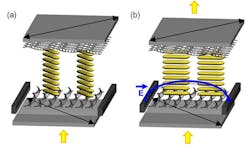Researchers from the Graduate School of Nanoscience and Technology (GSNT) at the Korea Advanced Institute of Science and Technology (KAIST; Daejeon, Republic of Korea) have demonstrated that DNA can align liquid crystal molecules, providing a convenient and inexpensive template for the fabrication of new liquid-crystal display (LCD) devices.
RELATED ARTICLE: Anti-counterfeiting program uses DNA to uniquely code computer chips
Deoxyribonucleic acid (DNA) is one of the world's most abundant naturally occurring molecules, is easily and cheaply extracted from animals and plants, and its structure and chemistry are well understood, making it an attractive substance for applications in materials science. Its regular 3D helical structure (and resulting molecular grooves) make DNA an ideal templating material for the alignment of other nanomaterials, including liquid crystal (LC) molecules.
For use in LCD devices, LC molecules must be aligned, a process currently achieved using a polyimine template in a time-consuming and energy-intensive procedure. Using DNA, LC molecules can be aligned quickly and easily at ambient temperature.
Initially, the DNA chains themselves need to be aligned. To achieve this, the researchers spread an aqueous solution of double-stranded DNA over a patterned indium tin oxide glass substrate containing in-plane electrodes. The solution is brushed in one direction using a store-bought makeup brush, and the water evaporated, producing a thin film of DNA chains aligned along the brushing direction. The LC molecules are then heated and introduced to the brush-aligned DNA film as an isotropic liquid. No light is transmitted when the sample is rotated to an angle of 35 degrees to either of the polarizers of the microscope, indicating that the LC molecules possess inclined orientation of about 35 degrees on the DNA surface. This LC orientation is ideal for LCD applications.
Next, the team was able to fabricate an in-plane switching LCD cell, currently the most widely used in industry, as it provides wide-viewing angles, clear images, and stable response times. Without an applied electric field (E), the LC molecules are oriented at an oblique angle to the direction of the electrode. Accordingly, polarized light passing through the LCs is blocked by the top polarizer, giving a dark mode. When an in-plane E is applied, the LC molecules reorient parallel to E, allowing the polarized light to be transmitted through the cell, producing a bright mode.
In summary, a film of brush-aligned DNA can be used as a template to fabricate an LCD cell, in which the LC molecules align at an oblique angle to the long axis of DNA. This process is fast, simple, and more energy-efficient than the current industry standard, and produces high-quality LCD cells. We believe these results constitute a convenient method for the integration of DNA templates into commercial LCD devices, and pave the way for the use of DNA in various other optical applications, including solar cells and field-effect transistors.
SOURCE: SPIE Newsroom; http://spie.org/newsroom/6424-dna-as-a-template-for-liquid-crystal-displays?highlight=x2400&WT.mc_id=KNRNANOE

Gail Overton | Senior Editor (2004-2020)
Gail has more than 30 years of engineering, marketing, product management, and editorial experience in the photonics and optical communications industry. Before joining the staff at Laser Focus World in 2004, she held many product management and product marketing roles in the fiber-optics industry, most notably at Hughes (El Segundo, CA), GTE Labs (Waltham, MA), Corning (Corning, NY), Photon Kinetics (Beaverton, OR), and Newport Corporation (Irvine, CA). During her marketing career, Gail published articles in WDM Solutions and Sensors magazine and traveled internationally to conduct product and sales training. Gail received her BS degree in physics, with an emphasis in optics, from San Diego State University in San Diego, CA in May 1986.
